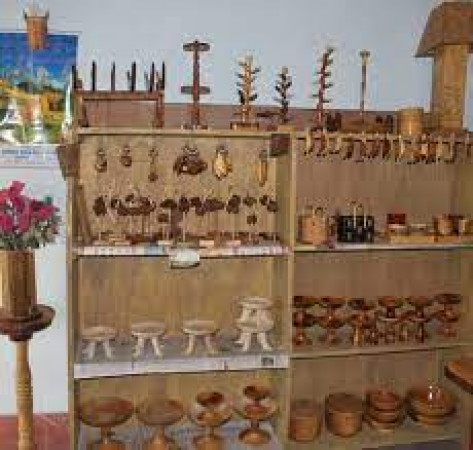Diezephe Village Travel Guide
Diezephe Village, located in Nagaland, India, is a hidden gem known for its rich Naga culture and stunning natural beauty. This quaint village is steeped in history, with traditional stone houses and intricate wood carvings that reflect the local heritage. Diezephe is famous for its vibrant festivals, such as the Hornbill Festival, which showcases the indigenous tribes' colorful dances, music, and crafts.Top Attractions in Diezephe Village
- Diezephe Craft Village
- Dzulekie Waterfall
- Khonoma Village
- Japfu Peak
- Kohima War Cemetery
Diezephe Village is Famous for
Handcrafted Naga artifacts and traditional cultural experiences.Top Attractions in Diezephe Village
- Explore the Diezephe Craft Village
- Chase the Dzulekie Waterfall
- Immerse in the heritage at Khonoma Village
- Hike up the Japfu Peak for breathtaking views
- Pay respects at the Kohima War Cemetery
What's Great about Travelling to Diezephe Village?
- Immersive cultural experiences
- Scenic beauty and peaceful surroundings
- Opportunity to witness traditional Naga festivals
What's Not So Great about Travelling to Diezephe Village?
- Limited accommodation options
- Rough and narrow roads for transportation
- Minimal nightlife and shopping opportunities
Travel Tips for Diezephe Village
- Obtain Inner Line Permit for Nagaland
- Prefer hiring a local guide for better exploration
- Respect the local customs and traditions
Important Diezephe Village trip information
- Ideal Duration: 2-3 days
- Best Time to Visit: October to March
- Nearby Airports and Railway Stations: Dimapur Airport and Dimapur Railway Station
FAQ's on Diezephe Village
Q1: What is the best time to visit Diezephe Village?
Diezephe Village is best visited during the winter months from November to February when the weather is cool and pleasant, making it ideal for exploring the village and its surroundings. This period also coincides with the Hornbill Festival, a major cultural event in Nagaland. However, do note that this is also the peak tourist season, so expect higher prices and larger crowds.
Q2: Do I need a visa to travel to Diezephe Village?
Most tourists traveling to Diezephe Village will need a valid Indian visa. However, citizens of some countries may be eligible for a visa on arrival or e-visa. It's essential to check the specific visa requirements based on your nationality before planning your trip. Make sure to have your travel documents in order to avoid any complications during your visit.
Q3: What are the must-visit attractions in Diezephe Village?
Diezephe Village offers a unique cultural experience with attractions like the Diezephe Craft Village, where you can witness traditional Naga crafts being made. The village is also known for its vibrant festivals and ceremonies, providing a glimpse into Naga tribal life. Don't miss the opportunity to explore the surrounding hills and forests for trekking and nature walks. Additionally, visiting local markets to try traditional Naga cuisine is a must-do while in Diezephe Village.
Q4: Is Diezephe Village a safe place to travel?
Diezephe Village is generally safe for tourists. However, like any destination, it's essential to take basic precautions such as safeguarding your belongings and being aware of your surroundings. It's advisable to respect local customs and traditions to ensure a smooth and enjoyable experience. As with any travel, it's recommended to stay informed about any potential risks and travel advisories before your trip.
Q5: What is the local currency in Diezephe Village and can I use credit cards?
The local currency in Diezephe Village, as in the rest of India, is the Indian Rupee (INR). While credit cards are accepted at some hotels and larger establishments, it's advisable to carry cash for transactions in local markets and smaller shops. ATMs are available in nearby towns, so it's recommended to withdraw cash before heading to remote areas like Diezephe Village.
Q6: What is the local cuisine like in Diezephe Village?
The local cuisine in Diezephe Village reflects Naga tribal traditions and includes dishes like smoked pork, bamboo shoot curry, and a variety of chutneys. Naga cuisine is known for its use of local ingredients and distinct flavors, offering a unique culinary experience for visitors. Vegetarian options are also available, with dishes made from locally sourced vegetables and herbs. It's recommended to try traditional Naga meals at local eateries or during cultural events to savor the authentic flavors of the region.
Q7: What transportation options are available in Diezephe Village?
Transportation options in Diezephe Village include buses, taxis, and rental cars. While public buses are available for travel within Nagaland, hiring a taxi or renting a car is more convenient for exploring remote areas like Diezephe Village. It's advisable to arrange transportation in advance or through local tour operators to ensure a smooth journey. Additionally, cycling or walking around the village is a great way to immerse yourself in the local culture and enjoy the scenic surroundings.
Q8: Are there any cultural norms or etiquette I should be aware of when visiting Diezephe Village?
When visiting Diezephe Village, it's important to respect the local customs and traditions of the Naga tribes. Dress modestly and avoid wearing revealing clothing, especially when visiting religious sites or participating in cultural events. Ask for permission before taking photographs of locals, as some may prefer not to be photographed. It's also customary to remove your shoes before entering someone's home or a traditional Naga hut. Greeting people with a friendly "hello" or "Kuzu zangpo" (in the local language) is appreciated. By showing respect for the local culture and traditions, you can have a more enriching and meaningful experience in Diezephe Village.
Q9: I am a travel agent. How can I buy travel leads of Diezephe Village?
Register yourself as a travel agent at agents.tripclap.com and then you can buy travel leads to Diezephe Village once your account is approved. For more details contact our support team at +91-8069186564 or support@tripclap.com

